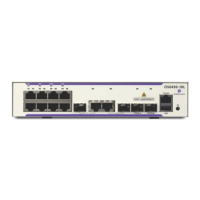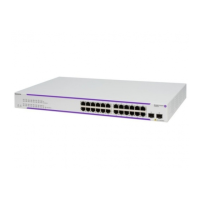OmniSwitch OS6860/OS6900/OS10K Troubleshooting Guide Part No.032996-00 Rev.A
AOS Release 7.X and 8.X January 2015
Alcatel-Lucent Page 72 of 148
3 128/127 128/127 128/128
4 256/255 256/255 256/256
5 256/255 256/256 256/256
6 256/254 256/254 256/256
7 256/254 256/256 256/256
8 256/255 256/254 256/254
9 256/255 256/256 256/256
1/1/(0) EFP 0/0 0 256/256 256/256 256/256
1 256/256 256/256 256/256
2 256/256 256/256 256/256
3 256/256 256/256 256/256
Layer 4, TCP/UDP ports, service groups and port ranges
A single TCP/UDP port rule will consume one TCAM rule. TCP/UDP port ranges consume one or
multiple TCAM rules entries depending on the range. 8 Hardware TCP/UDP ranges are available
and automatically used instead of the regular TCAM rules when the range is supposed to consume
6 or more than 6 rules.
The Classifier Processor on the ASIC has a separate table with a capacity of 8 TCP/UDP port ranges per
TCAM. Each port range will consume one TCAM entry and we can have 8 rules which use the TCP/UDP port
range table. However, the user can configure more than 8 TCP/UDP port ranges, additional TCP/UDP port
ranges consuming more than 5 TCAM rules are programmed to the TCAM using multiple TCAM entries.
Hardware TCP/UDP port ranges are only allocated for TCP/UDP port ranges that require 6 or more than 6
regular TCAM entries. TCP/UDP port ranges that can be programmed directly to the TCAM using less than 6
TCAM entries will not consume a hardware range table entry.
Understanding the TCAM rule consumption for Layer 4 rules and TCP/UDP port ranges
Source and destination ports are 2 bytes long fields in the TCP/UDP headers. To understand the rules
consumption you need to convert the TCP/UDP value from decimal to binary and check which mask to apply
to fit to the port or port range, depending on the range a single may cover multiple values:
Single Port: 80 (decimal) -> (binary) 80 = 00000000 01010000
value 00000000 01010000
mask 11111111 11111111
Consumes 1 TCAM rule
Port Range: 2-3 (decimal) -> (binary) 2 = 00000000 00000010
3 = 00000000 00000011
value00000000 00000010
mask 11111111 11111110
Consumes 1 TCAM rule
In this example, ports 2 and 3 can use the same mask. The first 15 bits for port 2 and port 3 are identical.
Port Range: 2-4 (decimal) -> (binary) 2 = 00000000 00000010
3 = 00000000 00000011
4 = 00000000 00000100
Consumes 2 TCAM rules
One single rule is used to perform a match when the port number is equal 2 or 3 since both values share a
common mask:
TCAM rule 1 value1 00000000 00000010 (match port 2-3)
mask1 11111111 11111110 (mask port 2-3)
One additional TCAM rule is used to match when the port number equals to 4:
TCAM rule 2 value2 00000000 00000100 (match port 4)
mask2 11111111 11111111 (mask port 4)

